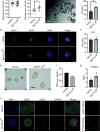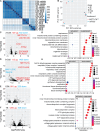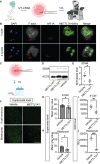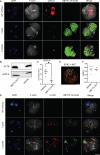This is a preprint.
METTL7A improves bovine IVF embryo competence by attenuating oxidative stress
- PMID: 39763908
- PMCID: PMC11702634
- DOI: 10.1101/2024.12.17.628915
METTL7A improves bovine IVF embryo competence by attenuating oxidative stress
Update in
-
METTL7A improves bovine IVF embryo competence by attenuating oxidative stress†.Biol Reprod. 2025 Apr 13;112(4):628-639. doi: 10.1093/biolre/ioaf018. Biol Reprod. 2025. PMID: 39883095
Abstract
In vitro fertilization (IVF) is a widely used assisted reproductive technology to achieve a successful pregnancy. However, the acquisition of oxidative stress in embryo in vitro culture impairs its competence. Here, we demonstrated that a nuclear coding gene, methyltransferase-like protein 7A (METTL7A), improves the developmental potential of bovine embryos. We found that exogenous METTL7A modulates expression of genes involved in embryonic cell mitochondrial pathways and promotes trophectoderm development. Surprisingly, we discovered that METTL7A alleviates mitochondrial stress and DNA damage and promotes cell cycle progression during embryo cleavage. In summary, we have identified a novel mitochondria stress eliminating mechanism regulated by METTL7A that occurs during the acquisition of oxidative stress in embryo in vitro culture. This discovery lays the groundwork for the development of METTL7A as a promising therapeutic target for IVF embryo competence.
Keywords: DNA damage; IVF; METTL7A; embryo competence; mitochondria; oxidative stress.
Conflict of interest statement
Competing interests The findings of this study were included in a U.S provisional patent application 63/698,174.
Figures




Similar articles
-
METTL7A improves bovine IVF embryo competence by attenuating oxidative stress†.Biol Reprod. 2025 Apr 13;112(4):628-639. doi: 10.1093/biolre/ioaf018. Biol Reprod. 2025. PMID: 39883095
-
A pre-in vitro maturation medium containing cumulus oocyte complex ligand-receptor signaling molecules maintains meiotic arrest, supports the cumulus oocyte complex and improves oocyte developmental competence.Mol Hum Reprod. 2017 Sep 1;23(9):594-606. doi: 10.1093/molehr/gax032. Mol Hum Reprod. 2017. PMID: 28586460
-
Mitochondria-targeted therapy rescues development and quality of embryos derived from oocytes matured under oxidative stress conditions: a bovine in vitro model.Hum Reprod. 2019 Oct 2;34(10):1984-1998. doi: 10.1093/humrep/dez161. Hum Reprod. 2019. PMID: 31625574
-
Guidelines for the number of embryos to transfer following in vitro fertilization No. 182, September 2006.Int J Gynaecol Obstet. 2008 Aug;102(2):203-16. doi: 10.1016/j.ijgo.2008.01.007. Int J Gynaecol Obstet. 2008. PMID: 18773532 Review.
-
Is mitochondrial DNA quantitation in blastocyst trophectoderm cells predictive of developmental competence and outcome in clinical IVF?J Assist Reprod Genet. 2017 Dec;34(12):1581-1585. doi: 10.1007/s10815-017-1072-6. Epub 2017 Oct 28. J Assist Reprod Genet. 2017. PMID: 29080967 Free PMC article. Review.
Cited by
-
Applying blood-derived epigenetic algorithms to saliva: cross-tissue similarity of DNA-methylation indices of aging, physiology, and cognition.Clin Epigenetics. 2025 Apr 23;17(1):61. doi: 10.1186/s13148-025-01868-2. Clin Epigenetics. 2025. PMID: 40270051 Free PMC article.
References
-
- 2021 Assited Reproduction Technology (ART) Fertility Clinic and National Summary Report [https://www.cdc.gov/art/reports/2021/summary.html]
-
- Viana JHM: 2022 Statistics of embryo production and transfer in domestic farm animals: the main trends for the world embryo industry still stand. In: Embryo Technology Newsletter. vol. 41. International Embryo Technologies Society; 2023: 20–38.
-
- Gardner DK, Kelley RL: Impact of the IVF laboratory environment on human preimplantation embryo phenotype. J Dev Orig Health Dis 2017, 8(4):418–435. - PubMed
-
- Hansen PJ: Implications of Assisted Reproductive Technologies for Pregnancy Outcomes in Mammals. Annu Rev Anim Biosci 2020, 8:395–413. - PubMed
-
- Lin J, Wang L: Oxidative Stress in Oocytes and Embryo Development: Implications for In Vitro Systems. Antioxid Redox Signal 2020. - PubMed
Publication types
Grants and funding
LinkOut - more resources
Full Text Sources
Miscellaneous
